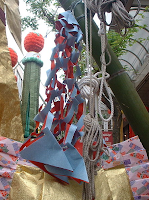It's summertime and firework season in Japan.
Every July/August a lot of fireworks festivals (花火大会, hanabi taikai) are held all over Japan. The fireworks can be small (around 1,000 shots) or very huge(around 39,000 shots) and can attract up to 1,300,000 visitors. Street vendors sell various drinks, Japanese food and held traditional festival games. Visitors are usually dressed in a Yukata (summer Kimono).
These festivals are very popular for companies, as they can act as sponsors.
They usually buy space on the festival’s pamphlet and make announcements during the event. Most of the time companies want to promote their name to local people, in order to develop in that region.
Also foreign companies in or outside Japan, who want to raise awareness, can reach with this kind of promotion a lot of people. Nearly all Japanese will join at least one Hanabi.
In Nagogata a very unique sponsoring was developed. We call it something like “private fireworks sponsorship”. People can sponsor privately to the fireworks committee and then parts of the fireworks will be shot with a personal message, which often include engagement messages.
These events are part of the Japanese culture and for companies really a good and unique promotion platform.
To those of you who haven't been on summer vacation yet: Enjoy!
Edda
Monday, July 25, 2011
Thursday, July 7, 2011
Tanabata Festival Sendai
Today I would like to write a bit about the Tanabata festival, which is held at many places of Japan in summer.
The famous Tanabate festival is held in Sendai, the area which was damaged by the huge earthquake and tsunami in March of this year. This is also the reason why we think it's a topic for this blog and we all hope that this festival will help Sendai at least a little bit to recover from its damage.


Tanabata (meaning "evening of the seventh") is a Japanese star festival and celebrates the meeting of the deities Orihime and Hikoboshi, which are represented by the stars Vega and Altair. According to a legend, the Milkey Way separates these lovers, and they are allowed to meet only once a year on the seventh day of the seventh lunar month of the lunisolar calender. The date of Tanabata varies by region of the country, but the first festivities begin on July 7 of the Gregorian calender and is held at night (Sorce: Wikipedia).
As I mentioned, the biggest Tanabata festival is celebrated in Sendai and is especially this year of great importance. It will be held from August 6-8.
(http://www.sendaitanabata.com/index.html Japanese only)
At the Sendai Tanabata festival, people traditionally use seven different kinds of decorations, which each represent different meanings. The seven decorations and their symbolic meanings are:

Paper strips (短冊; Tanzaku) : Wishes for good handwriting and studies

Paper Kimono (紙衣; Kamigoromo) : Wishes for good sewing. Wards off accidents and bad health

Paper Crane (折り鶴; Orizuru) : Family safety, health, and long life

Trash Bag (くずかご; Kuzukago) : Cleanliness and thriftyness
The famous Tanabate festival is held in Sendai, the area which was damaged by the huge earthquake and tsunami in March of this year. This is also the reason why we think it's a topic for this blog and we all hope that this festival will help Sendai at least a little bit to recover from its damage.


Tanabata (meaning "evening of the seventh") is a Japanese star festival and celebrates the meeting of the deities Orihime and Hikoboshi, which are represented by the stars Vega and Altair. According to a legend, the Milkey Way separates these lovers, and they are allowed to meet only once a year on the seventh day of the seventh lunar month of the lunisolar calender. The date of Tanabata varies by region of the country, but the first festivities begin on July 7 of the Gregorian calender and is held at night (Sorce: Wikipedia).
As I mentioned, the biggest Tanabata festival is celebrated in Sendai and is especially this year of great importance. It will be held from August 6-8.
(http://www.sendaitanabata.com/index.html Japanese only)
At the Sendai Tanabata festival, people traditionally use seven different kinds of decorations, which each represent different meanings. The seven decorations and their symbolic meanings are:

Paper strips (短冊; Tanzaku) : Wishes for good handwriting and studies

Paper Kimono (紙衣; Kamigoromo) : Wishes for good sewing. Wards off accidents and bad health

Paper Crane (折り鶴; Orizuru) : Family safety, health, and long life

Paper Purse (巾着; Kinchaku) : Good business

Net (投網; Toami) : Good fishing and harvests

Trash Bag (くずかご; Kuzukago) : Cleanliness and thriftyness

Streamers (吹き流し; Fukinagashi) : The strings that Orihime uses to weave
(Source: Wikipedia)
We really hope very much that this festival will help Sendai at least a little bit to recover from the damage and that the citizens of Sendai will for some hours have a good time and forget the earthquake for a while.
Best,
Edda
Labels:
Celebration,
Sendai,
Summer festival,
Tanabata Festival,
Tradition
Subscribe to:
Comments (Atom)
